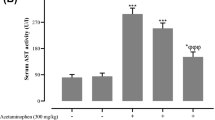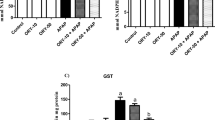Abstract
N-acetylcysteine (NAC) is an effective antidote to treat acetaminophen (APAP)-induced acute liver failure (ALF). NAC is hepatoprotective and prevents the neurological complications of ALF, namely hepatic encephalopathy and brain edema. The protective effect of NAC and its mechanisms of action in ALF due to other toxins, however, are still controversial. In the present study, we investigated the effects of NAC in relation to liver pathology, hepatic and cerebral glutathione, plasma ammonia concentrations, progression of encephalopathy, cerebral edema, and plasma proinflammatory cytokines in mice with ALF resulting from azoxymethane (AOM) hepatotoxicity, a well characterized model of toxic liver injury. Male C57BL/6 mice were treated with AOM (100 µg/g; i.p.) or saline and sacrificed at coma stage of encephalopathy in parallel with AOM mice administered NAC (1.2 g/kg; i.p.). AOM administration led to hepatic damage, significant increase in plasma transaminase activity, decreased hepatic glutathione levels and brain GSH/GSSG ratios as well as increased expression of plasma proinflammatory cytokines. NAC treatment of AOM mice led to reduced hepatic damage and improvement in neurological function, normalization of brain and hepatic glutathione levels as well as selective attenuation in expression of plasma proinflammatory cytokines. These findings demonstrate that the beneficial effects of NAC in experimental non-APAP-induced ALF involves both antioxidant and anti-inflammatory mechanisms.





Similar content being viewed by others
Abbreviations
- ALF:
-
acute liver failure
- AOM:
-
azoxymethane
- APAP:
-
acetaminophen
- BBB:
-
blood-brain barrier
- NAC:
-
N-acetylcysteine
- IFN-γ:
-
interferon gamma
- IL:
-
interleukin
- TNF-α:
-
tumor necrosis factor alpha
- SIRS:
-
systemic inflammatory response syndrome
- ALT:
-
alanine aminotransferase
References
Banks WA (2005) Blood-brain barrier transport of cytokines: a mechanism for neuropathology. Curr Pharm Des 11:973–984
Bélanger M, Coté J, Butterworth RF (2006) Neurobiological characterization of an azoxymethane mouse model of acute liver failure. Neurochem Int 48:434–440
Ben-Ari Z, Vaknin H, Tur-Kaspa R (2000) N-acetylcysteine in acute hepatic failure (non-paracetamol-induced). Hepatogastroenterology 47:786–789
Boess F, Bopst M, Althaus R, Polsky S, Cohen SD, Eugster HP, Boelsterli UA (1998) Acetaminophen hepatotoxicity in tumor necrosis factor/lymphotoxin-alpha gene knockout mice. Hepatology 27:1021–1029
Corcoran GB, Wong BK (1986) Role of glutathione in prevention of acetaminophen-induced hepatotoxicity by N-acetyl-L-cysteine in vivo: studies with N-acetyl-D-cysteine in mice. J Pharmacol Exp Ther 238:54–61
Fernando B, Marley R, Holt S, Anand R, Harry D, Sanderson P, Smith R, Hamilton G, Moore K (1998) N-acetylcysteine prevents development of the hyperdynamic circulation in the portal hypertensive rat. Hepatology 28:689–694
Gately MK, Warrier RR, Honasoge S, Carvajal DM, Faherty DA, Connaughton SE, Anderson TD, Sarmiento U, Hubbard BR, Murphy M (1994) Administration of recombinant IL-12 to normal mice enhances cytolytic lymphocyte activity and induces production of IFN-gamma in vivo. Int Immunol 6:157–167
Harrison PM, Keays R, Bray GP, Alexander GJ, Williams R (1990) Improved outcome of paracetamol-induced fulminant hepatic failure by late administration of acetylcysteine. Lancet 335:1572–1573
Ishida Y, Kondo T, Ohshima T, Fujiwara H, Iwakura Y, Mukaida N (2002) A pivotal involvement of IFN-gamma in the pathogenesis of acetaminophen-induced acute liver injury. FASEB J 16:1227–1236
Jalan R, Williams R (2001) The inflammatory basis of intracranial hypertension in acute liver failure. J Hepatol 34:940–942
Jalan R, Olde Damink SW, Deutz NE, Hayes PC, Lee A (2004) Moderate hypothermia in patients with acute liver failure and uncontrolled intracranial hypertension. Gastroenterology 127:1338–1346
James LP, McCullough SS, Lamps LW, Hinson JA (2003) Effect of N-acetylcysteine on acetaminophen toxicity in mice: relationship to reactive nitrogen and cytokine formation. Toxicol Sci 75:458–467
James LP, Simpson PM, Farrar HC, Kearns GL, Wasserman GS, Blumer JL, Reed MD, Sullivan JE, Hinson JA (2005) Cytokines and toxicity in acetaminophen overdose. J Clin Pharmacol 45:1165–1171
Jiang W, Desjardins P, Butterworth RF (2009) Direct evidence for central proinflammatory mechanisms in rats with experimental acute liver failure: protective effect of hypothermia. J Cereb Blood Flow Metab 29:944–952
Kortsalioudaki C, Taylor RM, Cheeseman P, Bansal S, Mieli-Vergani G, Dhawan A (2008) Safety and efficacy of N-acetylcysteine in children with non-acetaminophen-induced acute liver failure. Liver Transpl 14:25–30
Kozer E, Koren G (2001) Management of paracetamol overdose: current controversies. Drug Saf 24:503–512
Lee WM, Hynan LS, Rossaro L, Fontana RJ, Stravitz RT, Larson AM, Davern TJ 2nd, Murray NG, McCashland T, Reisch JS, Robuck PR, Acute Liver Failure Study Group (2009) Intravenous N-acetylcysteine improves transplant-free survival in early stage non-acetaminophen acute liver failure. Gastroenterology 137:856–864
Leifeld L, Cheng S, Ramakers J, Dumoulin FL, Trautwein C, Sauerbruch T, Spengler U (2002) Imbalanced intrahepatic expression of interleukin 12, interferon gamma, and interleukin 10 in fulminant hepatitis B. Hepatology 36:1001–1008
Licinio J, Wong ML (1997) Pathways and mechanisms for cytokine signaling of the central nervous system. J Clin Invest 100:2941–2947
Liu ZX, Govindarajan S, Kaplowitz N (2004) Innate immune system plays a critical role in determining the progression and severity of acetaminophen hepatotoxicity. Gastroenterology 127:1760–1774
Marmarou A, Poll W, Shulman K, Bhagavan H (1978) A simple gravimetric technique for measurement of cerebral edema. J Neurosurg 49:530–537
Matkowskyj KA, Marrero JA, Carroll RE, Danilkovich AV, Green RM, Benya RV (1999) Azoxymethane-induced fulminant hepatic failure in C57BL/6J mice: characterization of a new animal model. Am J Physiol 277:G455–462
Mumtaz K, Azam Z, Hamid S, Abid S, Memon S, Ali Shah H, Jafri W (2009) Role of N-acetylcysteine in adults with non-acetaminophen-induced acute liver failure in a center without the facility of liver transplantation. Hepatol Int doi:10.1007/s12072-009-9151-0
Nagaki M, Iwai H, Naiki T, Ohnishi H, Muto Y, Moriwaki H (2000) High levels of serum interleukin-10 and tumor necrosis factor-alpha are associated with fatality in fulminant hepatitis. J Infect Dis 182:1103–1108
Riordan SM, Williams R (2003) Mechanisms of hepatocyte injury, multiorgan failure, and prognostic criteria in acute liver failure. Semin Liver Dis 23:203–215
Rolando N, Wade J, Davalos M, Wendon J, Philpott-Howard J, Williams R (2000) The systemic inflammatory response syndrome in acute liver failure. Hepatology 32:734–739
Schmidt LE, Larsen FS (2006) Prognostic implications of hyperlactatemia, multiple organ failure, and systemic inflammatory response syndrome in patients with acetaminophen-induced acute liver failure. Crit Care Med 34:337–343
Sekiyama KD, Yoshiba M, Thomson AW (1994) Circulating proinflammatory cytokines (IL-1 beta, TNF-alpha, and IL-6) and IL-1 receptor antagonist (IL-1Ra) in fulminant hepatic failure and acute hepatitis. Clin Exp Immunol 98:71–77
Simpson KJ (1999) Cytokines, for better or worse? Eur J Gastroenterol Hepatol 11:957–966
Sklar GE, Subramaniam M (2004) Acetylcysteine treatment for non-acetaminophen-induced acute liver failure. Ann Pharmacother 38:498–500
Smilkstein MJ, Knapp GL, Kulig KW, Rumack BH (1988) Efficacy of oral N-acetylcysteine in the treatment of acetaminophen overdose. Analysis of the national multicenter study (1976 to 1985). N Engl J Med 319:1557–1562
Tietze F (1969) Enzymic method for quantitative determination of nanogram amounts of total and oxidized glutathione: applications to mammalian blood and other tissues. Anal Biochem 27:502–522
Vaquero J, Polson J, Chung C, Helenowski I, Schiodt FV, Reisch J, Lee WM, Blei AT (2003) Infection and the progression of hepatic encephalopathy in acute liver failure. Gastroenterology 125:755–764
Weiser S, Miu J, Ball HJ, Hunt NH (2007) Interferon-gamma synergises with tumour necrosis factor and lymphotoxin-alpha to enhance the mRNA and protein expression of adhesion molecules in mouse brain endothelial cells. Cytokine 37:84–91
Wong D, Dorovini-Zis K, Vincent SR (2004) Cytokines, nitric oxide, and cGMP modulate the permeability of an in vitro model of the human blood-brain barrier. Exp Neurol 190:446–455
Yam LT, Li CY, Crosby WH (1971) Cytochemical identification of monocytes and granulocytes. Am J Clin Pathol 55:283–290
Yasumi Y, Takikawa Y, Endo R, Suzuki K (2007) Interleukin-17 as a new marker of severity of acute hepatic injury. Hepatol Res 37:248–254
Zafarullah M, Li WQ, Sylvester J, Ahmad M (2003) Molecular mechanisms of N-acetylcysteine actions. Cell Mol Life Sci 60:6–20
Acknowledgments
This study was supported by a grant from the Canadian Institutes for Health Research. C.B. is a recipient of a fellowship from the Canadian Association for the Study of the Liver (CASL)/Astellas Pharma Canada. J.V. was supported by a fellowship from CASL/Schering Canada.
Author information
Authors and Affiliations
Corresponding author
Rights and permissions
About this article
Cite this article
Bémeur, C., Vaquero, J., Desjardins, P. et al. N-Acetylcysteine attenuates cerebral complications of non-acetaminophen-induced acute liver failure in mice: antioxidant and anti-inflammatory mechanisms. Metab Brain Dis 25, 241–249 (2010). https://doi.org/10.1007/s11011-010-9201-2
Received:
Accepted:
Published:
Issue Date:
DOI: https://doi.org/10.1007/s11011-010-9201-2




